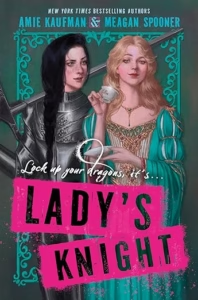Lady’s Knight
Amie Kaufman and Meagan Spooner
Storytide
Published June 3, 2025
Amazon | Bookshop | Goodreads
About Lady’s Knight
An undeniably fierce, unforgettably funny, unapologetically queer feminist romp through the England of medieval legend. Bestselling and acclaimed authors Amie Kaufman and Meagan Spooner bring readers along on an epic quest for valor, freedom, and, above all, love. A Knight’s Tale meets the Lady Jane series, with a dash of The Great!
Gwen is sick of hiding—hiding the fact that she’s taken over her father’s blacksmithing duties, hiding her attraction to girls, hiding her yearning for glory as a knight.
Meanwhile, Lady Isobelle of Avington, queen bee of the castle, has never once considered hiding who she is—until now. She’s been chosen as the grand prize in the Tournament of Dragonslayers, to be given to whichever knight can claim her hand. And for the first time in her life, she can’t talk her way out of trouble.
When Isobelle discovers Gwen’s knightly ambitions, they hatch a scheme together—Gwen will joust in the tournament, disguised as Sir Gawain. Winning means freedom for Isobelle, and glory for Gwen. Losing means… well, let’s not go there.
One thing’s for sure: falling in love was never the plan.
But the best laid plans…are often trampled all over by dragons.
My Review
It’s been a minute since I’ve read anything by this duo, but I remember that I enjoyed the last book by Kaufman and Spooner that I read. This novel is a lot of fun, as one familiar with the authors would expect. The characters have serious moments, but they’re often punctuated by asides that highlight the irony of a situation or point out a paradox in the culture of the time.
The characters speak to one another in fairly modern language, which might be challenging for die-hard historical fiction fans, but will make the story more accessible for readers who generally read contemporary fiction.
The romance between Gwen and Isobelle is so sweet. They have very different personalities, and that made watching them fall in love such a joy. Isobelle is the kind of character that might be easy to write off as too silly or shallow at first, but as you get to know her, you see how she uses humor or frivolity to mask her true self. It’s not safe for her to be any other way.
The pragmatic and serious Gwen challenges Isobelle to speak up more, and in return, Isobelle challenges Gwen to believe in herself and take risks. They make a fabulous couple. I loved some of the side characters, especially Olivia, Isobelle’s maid (with a much more exciting history) and Madame DuPont, the swordswoman who helps Gwen prepare for the tournament.
The author acknowledgements say this is the first book in a series, and I say, bring it! I’m absolutely here for more adventures in this story world.
Content Notes
Recommended for Ages 14 up.
Profanity/Crude Language Content
Strong profanity used infrequently.
Romance/Sexual Content
Kissing.
Spiritual Content
Some characters are hedge witches, who use healing herbs to help sick or wounded people and uplift women and marginalized people.
Violent Content
Situations of peril. Some scenes show knights competing at jousting, which can be deadly. Some participants injure their opponents.
Drug Content
Characters drink alcohol and play a drinking game (a medieval version of Never Have I Ever).
Note: This post contains affiliate links, which do not cost you anything to use but help support this blog. I received a free copy of this book in exchange for my honest review. All opinions are my own.
